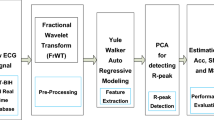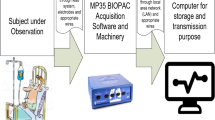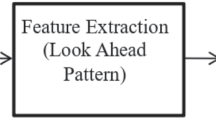Abstract
In general, Electrocardiogram (ECG) signal gets corrupted by variety of noise at the time of its acquisition. Unfortunately, these noise tend to mask the crucial information. Consequently, it may endanger life of the subject (patient) due to delayed diagnosis of heart health. In critical situations, proper analysis of ECG signals is very important for correct and timely detection of heart diseases. This situation motivated the present authors to develop an efficient arrhythmia detection algorithm. In this paper, a novel fractional wavelet transform (FrWT), Yule–Walker Autoregressive Analysis (YWARA), and Principal Component Analysis (PCA) are used for preprocessing, feature extraction, and detection, respectively. The type of arrhythmia detected has been interpreted based on variance estimation theory. For performance evaluation, various statistical parameters such as mean square error (MSE), detection accuracy (Acc), & output signal-to-noise ratio (SNR) are used. The proposed algorithm achieved a MSE of 0.1656%, Acc of 99.89%, & output SNR of 25.25 dB for MIT-BIH Arrhythmia database. For complete validation of this proposed work, other databases such as ventricular tachyarrhythmia, MIT-BIH long-term, and atrial fibrillation are also utilized.




Similar content being viewed by others
Data Availability
Available on physionet website (https://physionet.org).
Material Availability
Software application which is developed by present authors.
References
Mehta, S.S., Lingayat, N.S. (2008). Detection of P and T-waves in electrocardiogram. World Congress on Engineering and Computer Science (WCECS-2008) pp. 1–6.
Gupta, V., Mittal, M., & Mittal, V. (2019). R-peak detection based chaos analysis of ECG signal. Analog Integrated circuits and Signal Processing, 102, 479–490.
Elgendi, M. (2013). Fast QRS detection with an optimized knowledge-based method: Evaluation on 11 standard ECG databases. PLoS ONE, 8(9), e73557. https://doi.org/10.1371/journal.pone.0073557,2013
Elgendi, M., Jonkman, M., & Boer, F. D. (2009). Improved QRS detection algorithm using dynamic thresholds. International Journal of Hybrid Information Technology, 2(1), 65–80.
Elgendi, M., Eskofier, B., Dokos, S., & Abbott, D. (2014). Revisiting QRS detection methodologies for portable, wearable, battery-operated, and wireless ECG systems. PLoS ONE, 9(1), e84018. https://doi.org/10.1371/journal.pone.0084018
Gupta, V., Mittal, M., & Mittal, V. (2021). An efficient low computational cost method of R-peak detection. Wireless Personal Communications. https://doi.org/10.1007/s11277-020-08017-3
Park, J. S., Lee, S. W., & Park, U. (2017). R peak detection method using wavelet transform and modifed shannon energy envelope. Journal of Healthcare Engineering, 17, 1–14. https://doi.org/10.1155/2017/4901017
Elgendi, M., Meo, M., & Abbott, D. (2016). A proof-of-concept study: Simple and effective detection of P and t waves in arrhythmic ECG signals. Bioengineering, 3, 26. https://doi.org/10.3390/bioengineering3040026
Sahoo, S., Biswal, P., Das, T., & Sabut, S. (2016). De-noising of ECG signal and QRS detection using Hilbert transform and adaptive thresholding. Procedia Technology, 25, 68–75.
Martis, R. J., Acharya, U. R., Mandana, K. M., Ray, A. K., & Chakraborty, C. (2012). Application of principal component analysis to ECG signals for automated diagnosis of cardiac health. Journal of Expert Systems with Applications, 39, 11792–11800.
Gupta, V., & Mittal, M. (2020). Arrhythmia detection in ECG signal using fractional wavelet transform with principal component analysis. Journal of The Institution of Engineers India Series B. https://doi.org/10.1007/s40031-020-00488-z
Xingyuan, W., & Juan, M. (2009). Wavelet-based hybrid ECG compression technique. Analog Integrated Circuits and Signal Processing, 59(3), 301–308.
Rajankar, S. O., & Talbar, S. N. (2019). An electrocardiogram signal compression techniques: A comprehensive review. Analog Integrated Circuits and Signal Processing, 98(1), 59–74.
Singh, D., Saini, B. S., & Kumar, V. (2008). Heart rate variability—A bibliographical survey. IETE Journal of Research, 54(3), 209–216.
Kaur, H., & Rajni, R. (2017). On the detection of cardiac arrhythmia with principal component analysis. Journal of Wireless Personal Communications, 97(4), 5495–5509.
Gupta, V., Kanungo, A., Kumar, P., Sharma, A. K., & Gupta, A. (2018). Auto-regressive time frequency analysis (ARTFA) of electrocardiogram (ECG) signal. International Journal of Applied Engineering Research, 13(6), 133–138.
Addison, P. S. (2005). Wavelet transforms and the ECG: A review. Physiological Measurement, 26, 155–199.
Rawal, K., Saini, B. S., & Saini, I. (2017). Effect of age and postural related changes on cardiac autonomic function in the pre-menopausal and post-menopausal women. International Journal of Medical Engineering and Informatics, 9(4), 299–315.
Gupta, V. et al. (2021). ECG signal analysis using CWT, Spectrogram and autoregressive technique. Iran Journal of Computer Science, in press
Gupta, V., Mittal, M., and Mittal, V. (2022). An efficient AR modeling based electrocardiogram signal analysis for health informatics. International Journal of Medical Engineering and Informatics (IJMEI), in press.
Mortezaee, M., Mortezaie, Z., & Abolghasemi, V. (2019). An improved SSA-based technique for EMG removal from ECG. IRBM, 40, 62–68.
Chandra, S., Sharma, A., & Singh, G. K. (2019). Computationally efficient cosine modulated filter bank design for ECG signal compression. IRBM. https://doi.org/10.1016/j.irbm.2019.06.002
Gupta, V., et al. (2020). Performance evaluation of various pre-processing techniques for R-peak detection in ECG signal. IETE Journal of Research. https://doi.org/10.1080/03772063.2020.1756473
Gupta, V., & Mittal, M. (2020). Efficient R-peak detection in electrocardiogram signal based on features extracted using hilbert transform and burg method. Journal of the Institution of Engineers (India): Series B. https://doi.org/10.1007/s40031-020-00423-2
Jangra, M., et al. (2020). ECG arrhythmia classification using modified visual geometry group network (mVGGNet). Journal of Intelligent & Fuzzy Systems, 38, 3151–3165.
Dasgupta, H. (2016). Human age recognition by electrocardiogram signal based on artificial neural network. Sensing and Imaging, 17(4), 1–15.
Gupta, V., & Mittal, M. (2018). KNN and PCA classifier with autoregressive modelling during different ECG signal interpretation. Procedia Computer Science-Elsevier, 125, 18–24.
Gandhi, B., & Raghava, N. S. (2020). Fabrication techniques for carbon nanotubes based ECG electrodes: A review. IETE Journal of Research. https://doi.org/10.1080/03772063.2020.1768909
Dohare, A. K., et al. (2014). An efficient new method for the detection of QRS in electrocardiogram. Computers & Electrical Engineering, 40(5), 1717–1730.
Kaur, I., Rajni, R., & Marwaha, A. (2016). ECG signal analysis and arrhythmia detection using wavelet transform. Journal of the Institution of Engineers (India): Series B, 97(4), 499–507.
Rahman, A., et al. (2019). A statistical designing approach to MATLAB based functions for the ECG signal preprocessing. Iran Journal of Computer Science. https://doi.org/10.1007/s42044-019-00035-0
Sejdic, E., Djurovic, I., Jiang, J., & Stankovic, L. J. (2009). Time-frequency based feature extraction and classification: considering energy concentration as a feature using stockwell transform and related approaches (Vol. 1). VDM Verlag Publishing.
Gupta, V., and Mittal, M. (2018). ECG signal analysis: Past, present and future. In: Proc. 8th IEEE Power india international conference (PIICON), 10–12 Dec, 1–6, NIT Kurukshetra, Haryana, India (2018).
Marwaha, P., & Sunkaria, R. K. (2015). Cardiac variability time-series analysis by sample entropy and multiscale entropy. International Journal of Medical Engineering and Informatics, 7(1), 1–14.
Amar, D., & Abboud, S. (2016). P-wave morphology in focal atrial tachycardia using a 3D numerical model of the heart. International Journal of Medical Engineering and Informatics, 8(3), 263–274.
Salman, M. N., Rao, P. T., & Rahman, M. Z. U. (2017). Cardiac signal enhancement using normalised variable step algorithm for remote healthcare monitoring systems. International Journal of Medical Engineering and Informatics, 9(2), 145–161.
Murthy, H. S. N., & Meenakshi, M. (2017). Novel and efficient algorithms for early detection of myocardial ischemia. International Journal of Medical Engineering and Informatics, 9(4), 351–372.
Kamath, M.V., Bentley, T., Spaziani, R., Tougas, G., Fallen, E.L., McCartney, N., Runions, J., & Upton, A.R.M. (1996). Time–frequency analysis of heart rate variability signals in patients with autonomic dysfunction. In: International symposium on time–frequency and time-scale analysis (IEEE SP 1996), pp. 373–376
Singh, G., Gupta, V., Sekharmantri, A. K., Gupta, A., & Kumar, P. (2010). Real-time online monitoring of electrocardiogram(ECG) using very low cost for developing countries. AIP Conference Proceedings, 1324(1), 251–254.
Qin, S., Ji, Z. (2004). Multi-resolution time-frequency analysis for detection of rhythms of EEG signals. In: 2004 IEEE 11th digital signal processing workshop & IEEE signal processing education workshop (IEEE DSP 2004), pp 338–341
Meireles, A.J.M.D. (2011). ECG denoising based on adaptive signal processing technique. Thesis, Master of Technology in Electronics and Computer Science, Instituto Superior de Engenharia do Porto Portugal
Nayak, C., Saha, S. K., Kar, R., & Mandal, D. (2018). Optimal SSA based wideband digital differentiator design for cardiac QRS complex detection application. International Journal of Numerical Modelling: Electronic Networks, Devices and Fields, 32(2), 1–25.
Pan, J., & Tompkins, W. J. (1985). A real-time QRS detection algorithm. IEEE Transactions on Biomedical Engineering, 32, 230–236.
Sharma, A., Patidar, S., Upadhyaya, A., & Acharya, U. R. (2019). Accurate tunable-Q wavelet transform based method for QRS complex detection. Computers & Electrical Engineering, 75, 101–111.
Nallathambi, G., & Príncipe, J. C. (2014). Integrate and fire pulse train automaton for QRS detection. IEEE Transactions on Biomedical Engineering, 61(2), 317–326.
Pandit, D., Zhang, L., Liu, C., Chattopadhyay, S., Aslam, N., & Lim, C. P. (2017). A lightweight QRS detector for single lead ECG signals using a max-min difference algorithm. Computer Methods and Programs in Biomedicine, 144, 61–75.
Yakut, O., & Bolat, E. D. (2018). An improved QRS complex detection method having low computational load. Biomedical Signal Processing and Control, 42, 230–241.
Yazdani, S., & Vesin, J. M. (2016). Extraction of QRS fiducial points from the ECG using adaptive mathematical morphology. Digital Signal Processing, 56, 100–109.
Yazdani, A., Fallet, S., & Vasin, J. M. (2018). A novel short-term event extraction algorithm for biomedical signals. IEEE Transactions on Biomedical Engineering, 65(4), 754–762.
Biswal, B. (2017). ECG signal analysis using modified S-transform. Healthcare Technology Letters, 4(2), 68–72.
Nguomkam Negou, A., & Kengne, J. (2019). A minimal three-term chaotic flow with coexisting routes to chaos, multiple solutions, and its analog circuit realization. Analog Integrated Circuits and Signal Processing. https://doi.org/10.1007/s10470-019-01436-8
V. Gupta, et al., “Attractor plot as an emerging tool in ECG signal processing for improved health informatics,” International Conference on Future Technologies 2020 (ICOFT 2020) in Manufacturing, Automation, Design and Energy (MADE@NITPY), National Institute of Technology Puducherry Karaikal, India, December 28–30, 2020.
Gupta, V. et al. (2020). Spectrogram as an emerging tool in ECG signal processing. In: International conference on future technologies 2020 (ICOFT 2020) in manufacturing, automation, design and energy (MADE@NITPY), National Institute of Technology Puducherry Karaikal, India, 28–30 Dec 2020.
Gupta, V. et al. (2021). ECG signal analysis using emerging tools in current scenario of health informatics. In: 11th International conference on cloud computing, data science & engineering (Confluence 2021), Amity University Noida, India, 28–29 Jan 2021
Elgendi, M., Jonkman, M, & Boer, F. D. (2009). R wave detection using coiflets wavelets. In: 2009 IEEE 35th annual northeast bioengineering conference. Boston, MA, USA. https://doi.org/10.1109/NEBC.2009.4967756
Das, M., & Ari, S. (2013). Analysis of ECG signal denoising method based on S-transform. IRBM, 34(6), 362–370.
Luz, E. J. S., Schwartz, W. R., Chávez, G. C., & Menotti, D. (2016). ECG-based heartbeat classification for arrhythmiadetection: A survey. Computer Methods and Programs in Biomedicine, 127, 144–164.
Gupta, V., & Mittal, M. (2019). QRS complex detection using STFT, chaos analysis, and PCA in standard and real-time ECG databases. Journal of The Institution of Engineers (India): Series B. https://doi.org/10.1007/s40031-019-00398-9
Gupta, V., & Mittal, M. (2019). R-Peak detection in ECG signal using Yule–Walker and principal component analysis. IETE Journal of Research. https://doi.org/10.1080/03772063.2019.1575292
Gupta, V., & Mittal, M. (2018). Electrocardiogram signals interpretation using Chaos theory. Journal of Advanced Research in Dynamical and Control Systems, 10(2), 2392–2397.
Gupta, V., & Mittal, M. (2019). A novel method of cardiac arrhythmia detection in electrocardiogram signal. International Journal of Medical Engineering and Informatics, 12(5), 489–499.
Gupta, V., Mittal, M., Mittal, V. et al. (2021). Detection of R-peaks using fractional Fourier transform and principal component analysis. Journal of Ambient Intelligence and Humanized Computing. https://doi.org/10.1007/s12652-021-03484-3
Rai, H. M., Trivedi, A., Chatterjee, K., & Shukla, S. (2014). R-Peak detection using Daubechies wavelet and ECG signal classification using radial basis function neural network. Journal of The Institution of Engineers (India): Series B, 95(1), 63–71.
Bhatnagar, G., Wua, Q. M. J., & Raman, B. (2013). Discrete fractional wavelet transform and its application to multiple encryption. Information Sciences, 223, 297–316.
Ouelli, A., Elhadadi, B., Aissaoui, H., & Bouikhalene, B. (2012). AR modeling for cardiac arrhythmia classification using MLP neural networks. International Journal of Computer Applications, 47(24), 44–51.
Arnold, M., Miltner, W. H. R., Witte, H., Bauer, R., & Braun, C. (1998). Adaptive AR modeling of nonstationary time series by means of Kalman filtering. IEEE Transactions on Biomedical Engineering, 45(5), 553–562.
Chawla, M. P. S. (2008). Segment classification of ECG data and construction of scatter plots using principal component analysis. Journal of Mechanics in Medicine and Biology, 8(3), 421–458.
Physionet database/MITBIH Arrhythmia database. Accessed 22 Nov 2017
Slimane, Z. E. H., & Ali, A. N. (2010). QRS complex detection using empirical mode decomposition. Digital Signal Processing, 20(4), 1221–1228.
Narayanana, V. A., & Prabhu, K. M. M. (2003). The fractional Fourier transform: Theory, implementation and error analysis. Jornal of Microprocessors and Microsys, 27(10), 511–521.
Sejdic, E., Djurovic, I., Jiang, J., Stankovic, L.J. (2009). Time–frequency based feature extraction and classification: considering energy concentration as a feature using stockwell transform and related approaches. VDM Verlag Publishing Saarbrucken, Germany (2009). http://www.vdm-verlag.de.
Alfaouri, M., & Daqrouq, K. (2008). ECG signal denoising by wavelet transform thresholding. American Journal of Applied Sciences, 5(3), 276–281.
Gupta, V., & Mittal, M. (2019). A Comparison of ECG signal pre-processing using FrFT, FrWT and IPCA for improved analysis. Innovation and Research in BioMedical Engineering (IRBM). https://doi.org/10.1016/j.irbm.2019.04.003
Dliou, A., Latif, R., Laaboubi, M., & Maoulainine, F. M. R. (2014). Abnormal ECG signal analysis using non parametric time-frequency techniques. Arabian Journal Science Engineering, 39(2), 913–921.
Martis, R. J., Acharya, U. R., Lim, C. M., & Suri, J. S. (2013). Characterization of ECG beats from cardiac arrhythmia using discrete cosine. Knowledge-Based Systems, 45, 76–82.
Homaeinezhad, M. R., Atyabi, S. A., Tavakolli, E., Toosi, H. N., Ghaffari, A., & Ebrahimpour, R. (2012). ECG arrhythmia recognition via a neuro-SVM–KNN hybrid classifier with virtual QRS image-based geometrical features. Expert Systems with Applications, 39(2), 2047–2058.
Gupta, V., Mittal, M. (2016). Respiratory signal analysis using PCA, FFT and ARTFA. In: 2016 IEEE Proc. of ICEPES-16. Maulana Azad National Institute of Technology, Bhopal, India, 2016, pp. 221–225.
Lin, C. H. (2008). Frequency-domain features for ECG beat discrimination using grey relational analysis-based classifier. Computers & Mathematics with Applications, 55(4), 680–690.
Übeyli, E. D. (2009). Statistics over features of ECG signals. Expert Systems with Applications, 36(5), 8758–8767.
Güler, I., & Übeyli, E. D. (2005). ECG beat classifier designed by combined neural network model. Pattern Recognition, 38(2), 199–208.
Kay, S. M. (1988). Modern spectral estimation (1st ed., pp. 328–457). Prentice Hall.
Kallas, M., Honeine, P., Richard, C., Francis, C., Amoud, H. (2012). Prediction of time series using Yule–Walker equations with Kernels. In: 2012 IEEE int conf. on acoustics, speech and signal processing (ICASSP 2012), pp. 2185–2188
Tomar, A. (2016). Various classifiers based on their accuracy for age estimation through facial features. International Research Journal of Engineering and Technology, 3(7), 1679–1682.
Chawla, M. P. S. (2009). A comparative analysis of principal component and independent component techniques for electrocardiograms. Journal of Neural Computing and Applications, 18(6), 539–556.
Nikan, S., Sridhar, F.G., Bauer, M. Pattern recognition application in ECG arrhythmia classification. In: 10th Int joint conference on biomedical engineering systems and technologies (BIOSTEC 2017), pp.48–56
Yeh, Y. C., Wang, W. J., & Chiou, C. W. (2009). Cardiac arrhythmia diagnosis method using linear discriminant analysis on ECG signals. Measurement, 42(5), 778–789.
Gupta, V., Mittal, M., & Mittal, V. (2019). R-Peak detection using chaos analysis in standard and real time ECG databases. IRBM, 40(6), 341–354.
Mukhopadhyay, S., & Sircar, P. (1996). Parametric modelling of ECG signal. Journal Medical & Biological Engineering & Computing, 34(2), 171–174.
Gupta, V., Mittal, M., & Mittal, V. (2021). Chaos theory and ARTFA: emerging tools for interpreting ECG signals to diagnose cardiac arrhythmias. Wireless Personal Communications, 118, 3615–3646.
Gnana Subha, G., & Suja Priyadharsini, S. (2019). An efficient algorithm based on combined encoding techniques for compression of ECG data from multiple leads. Wireless Personal Communications, 108, 2137–2147. https://doi.org/10.1007/s11277-019-06513-9
Al-Dujaili, M. J., & Mezeel, M. T. (2021). Novel approach for reinforcement the extraction of ECG signal for twin fetuses based on modified BSS. Wireless Personal Communications, 119, 2431–2450.
Kalaivani, S., Tharini, C., Saranya, K., et al. (2020). Design and implementation of hybrid compression algorithm for personal health care big data applications. Wireless Personal Communications, 113, 599–615.
Gupta, V., Mittal, M., Mittal, V., et al. (2021). A critical review of feature extraction techniques for ECG signal analysis. Journal of The Institution of Engineers (India): Series B. https://doi.org/10.1007/s40031-021-00606-5
Huang, J. S., Chen, B. Q., Zeng, N. Y., et al. (2020). Accurate classification of ECG arrhythmia using MOWPT enhanced fast compression deep learning networks. Journal of Ambient Intelligence and Humanized Computing. https://doi.org/10.1007/s12652-020-02110-y
Author information
Authors and Affiliations
Contributions
All simulations and methodology are performed by VG. Literature survey and consideration of available datasets is done by MM. Motivation of the research on the ECG signal is suggested by VM.
Corresponding author
Ethics declarations
Confict of interest
Authors declare that they have no confict of interest.
Ethical Approval
AAll authors ensure the ethical approval.
Consent to Participate
All authors have the consent to participate.
Consent to Publish
All authors have the consent to publish the paper in this journal.
Additional information
Publisher's Note
Springer Nature remains neutral with regard to jurisdictional claims in published maps and institutional affiliations.
Rights and permissions
About this article
Cite this article
Gupta, V., Mittal, M. & Mittal, V. A Novel FrWT Based Arrhythmia Detection in ECG Signal Using YWARA and PCA. Wireless Pers Commun 124, 1229–1246 (2022). https://doi.org/10.1007/s11277-021-09403-1
Accepted:
Published:
Issue Date:
DOI: https://doi.org/10.1007/s11277-021-09403-1




